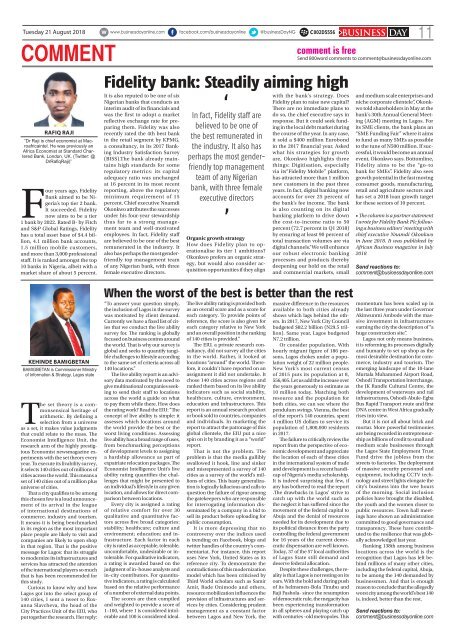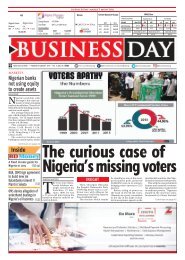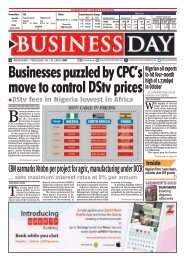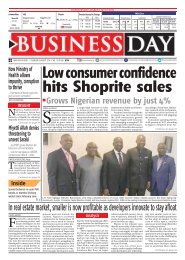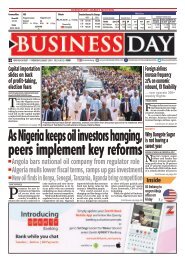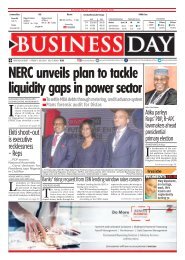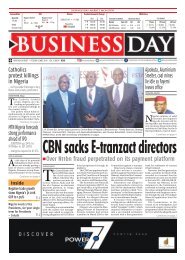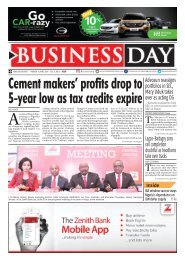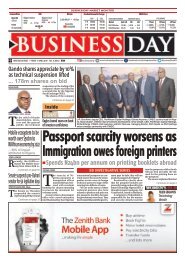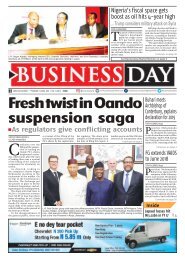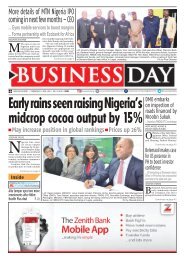BusinessDay 21 Aug 2018
You also want an ePaper? Increase the reach of your titles
YUMPU automatically turns print PDFs into web optimized ePapers that Google loves.
Tuesday <strong>21</strong> <strong>Aug</strong>ust <strong>2018</strong><br />
COMMENT<br />
RAFIQ RAJI<br />
“Dr Raji is chief economist at Macroafricaintel.<br />
He was previously an<br />
Africa Economist at Standard Chartered<br />
Bank, London, UK. (Twitter: @<br />
DrRafiqRaji)”<br />
Four years ago, Fidelity<br />
Bank aimed to be Nigeria’s<br />
top tier 2 bank.<br />
It succeeded. Fidelity<br />
now aims to be a tier<br />
1 bank by 2022. Rated B- by Fitch<br />
and S&P Global Ratings, Fidelity<br />
has a total asset base of $4.4 billion,<br />
4.1 million bank accounts,<br />
1.5 million mobile customers,<br />
and more than 3,000 professional<br />
staff. It is ranked amongst the top<br />
10 banks in Nigeria, albeit with a<br />
market share of about 5 percent.<br />
C002D5556<br />
comment is free<br />
Fidelity bank: Steadily aiming high<br />
It is also reputed to be one of six<br />
Nigerian banks that conducts an<br />
interim audit of its financials and<br />
was the first to adopt a market<br />
reflective exchange rate for preparing<br />
them. Fidelity was also<br />
recently rated the 4th best bank<br />
in the retail segment by KPMG,<br />
a consultancy, in its 2017 Banking<br />
Industry Satisfaction Survey<br />
(BISS).The bank already maintains<br />
high standards for some<br />
regulatory metrics: its capital<br />
adequacy ratio was unchanged<br />
at 16 percent in its most recent<br />
reporting, above the regulatory<br />
minimum requirement of 15<br />
percent. Chief executive Nnamdi<br />
Okonkwo attributes the successes<br />
under his four-year stewardship<br />
thus far to a strong management<br />
team and well-motivated<br />
employees. In fact, Fidelity staff<br />
are believed to be one of the best<br />
remunerated in the industry. It<br />
also has perhaps the most genderfriendly<br />
top management team<br />
of any Nigerian bank, with three<br />
female executive directors.<br />
‘<br />
In fact, Fidelity staff are<br />
believed to be one of<br />
the best remunerated in<br />
the industry. It also has<br />
perhaps the most genderfriendly<br />
top management<br />
team of any Nigerian<br />
bank, with three female<br />
executive directors<br />
’<br />
Organic growth strategy<br />
How does Fidelity plan to operationalise<br />
its tier 1 ambitions?<br />
Okonkwo prefers an organic strategy,<br />
but would also consider acquisition<br />
opportunities if they align<br />
Send 800word comments to comment@businessdayonline.com<br />
with the bank’s strategy. Does<br />
Fidelity plan to raise new capital?<br />
There are no immediate plans to<br />
do so, the chief executive says in<br />
response. But it could seek funding<br />
in the local debt market during<br />
the course of the year. In any case,<br />
it sold a $400 million Eurobond<br />
in the 2017 financial year. Asked<br />
what his strategies for growth<br />
are, Okonkwo highlights three<br />
things: Digitisation, especially<br />
via its“Fidelity Mobile” platform,<br />
has attracted more than 1 million<br />
new customers in the past three<br />
years. In fact, digital banking now<br />
accounts for over 25 percent of<br />
the bank’s fee income. The bank<br />
is also counting on its digital<br />
banking platform to drive down<br />
the cost-to-income ratio to 50<br />
percent (72.7 percent in Q1 <strong>2018</strong>)<br />
by ensuring at least 90 percent of<br />
total transaction volumes are via<br />
digital channels.“We will enhance<br />
our robust electronic banking<br />
processes and products thereby<br />
deepening our hold on the retail<br />
and commercial markets, small<br />
BUSINESS DAY<br />
11<br />
and medium scale enterprises and<br />
niche corporate clientele”, Okonkwo<br />
told shareholders in May at the<br />
bank’s 30th Annual General Meeting<br />
(AGM) meeting in Lagos. For<br />
its SME clients, the bank plans an<br />
“SME Funding Fair” where it aims<br />
to fund as many SMEs as possible<br />
to the tune of N500 million. If successful,<br />
it would become an annual<br />
event, Okonkwo says. Bottomline,<br />
Fidelity aims to be the “go-to<br />
bank for SMEs”. Fidelity also sees<br />
growth potential in the fast moving<br />
consumer goods, manufacturing,<br />
retail and agriculture sectors and<br />
has set a <strong>2018</strong> loan growth target<br />
for these sectors of 10 percent.<br />
• The column is a partner statement<br />
I wrote for Fidelity Bank Plc following<br />
a business editors’ meeting with<br />
chief executive Nnamdi Okonkwo<br />
in June <strong>2018</strong>. It was published by<br />
African Business magazine in July<br />
<strong>2018</strong><br />
Send reactions to:<br />
comment@businessdayonline.com<br />
KEHINDE BAMIGBETAN<br />
BAMIGBETAN is Commissioner Ministry<br />
of Information & Strategy, Lagos state<br />
The set theory is a commonsensical<br />
heritage of<br />
arithmetic. By defining a<br />
selection from a universe<br />
as a set, it makes value judgments<br />
that could relate to the mass. The<br />
Economist Intelligence Unit, the<br />
research arm of the highly prestigious<br />
Economist newsmagazine experiments<br />
with the set theory every<br />
year. To execute its livability survey,<br />
it selects 140 cities out of millions of<br />
cities across the world. This means a<br />
set of 140 cities out of a million plus<br />
universe of cities.<br />
That a city qualifies to be among<br />
this chosen few is a loud announcement<br />
of its arrival in the league<br />
of international destinations of<br />
commerce, industry and tourism.<br />
It means it is being benchmarked<br />
in its region as the most important<br />
place people are likely to visit and<br />
companies are likely to open shop<br />
in that region. That is the positive<br />
message for Lagos: that its struggle<br />
to modernize its infrastructures and<br />
services has attracted the attention<br />
of the international players so much<br />
that is has been recommended for<br />
this study.<br />
Curious to know why and how<br />
Lagos got into the select group of<br />
140 cities, I sent a tweet to Roxanna<br />
Slavcheva, the head of the<br />
City Practices Unit of the EIU, who<br />
put together the research. Her reply:<br />
When the worst of the best is better than the rest<br />
“To answer your question simply,<br />
the inclusion of Lagos in the survey<br />
was motivated by client demand.<br />
Currently we have a fixed list of cities<br />
that we conduct the live ability<br />
survey for. The ranking is globally<br />
focused on business centres around<br />
the world. That is why our survey is<br />
global and seeks to quantify tangible<br />
challenges to lifestyle according<br />
to the same set of criteria across all<br />
140 locations.”<br />
The live ability report is an advisory<br />
data motivated by the need to<br />
give multinational companies seeking<br />
to send their staff to locations<br />
across the world a guide on what<br />
to pay them while there. How does<br />
the rating work? Read the EIU: “The<br />
concept of live ability is simple: it<br />
assesses which locations around<br />
the world provide the best or the<br />
worst living conditions. Assessing<br />
live ability has a broad range of uses,<br />
from benchmarking perceptions<br />
of development levels to assigning<br />
a hardship allowance as part of<br />
expatriate relocation packages. The<br />
Economist Intelligence Unit’s live<br />
ability rating quantifies the challenges<br />
that might be presented to<br />
an individual’s lifestyle in any given<br />
location, and allows for direct comparison<br />
between locations.<br />
Every city is assigned a rating<br />
of relative comfort for over 30<br />
qualitative and quantitative factors<br />
across five broad categories:<br />
stability; healthcare; culture and<br />
environment; education; and infrastructure.<br />
Each factor in each<br />
city is rated as acceptable, tolerable,<br />
uncomfortable, undesirable or intolerable.<br />
For qualitative indicators,<br />
a rating is awarded based on the<br />
judgment of in–house analysts and<br />
in–city contributors. For quantitative<br />
indicators, a rating is calculated<br />
based on the relative performance<br />
of a number of external data points.<br />
The scores are then compiled<br />
and weighted to provide a score of<br />
1–100, where 1 is considered intolerable<br />
and 100 is considered ideal.<br />
The live ability rating is provided both<br />
as an overall score and as a score for<br />
each category. To provide points of<br />
reference, the score is also given for<br />
each category relative to New York<br />
and an overall position in the ranking<br />
of 140 cities is provided.”<br />
The EIU, a private research consultancy,<br />
did not survey all the cities<br />
in the world. Rather, it looked at<br />
locations “around” the world. Therefore,<br />
it couldn’t have reported on an<br />
assignment it did not undertake. It<br />
chose 140 cities across regions and<br />
ranked them based on its live ability<br />
indicators such as social stability,<br />
healthcare, culture, environment,<br />
education and infrastructures. This<br />
report is an annual research product<br />
or book sold to countries, companies<br />
and individuals. In marketing the<br />
report to attract the patronage of this<br />
global clientele, the EIU put a nice<br />
spin on it by branding it as a “world”<br />
report.<br />
That is not the problem. The<br />
problem is that the media gullibly<br />
swallowed it hook, line and sinker<br />
and misrepresented a survey of 140<br />
cities as a survey of the world’s millions<br />
of cities. This hasty generalization<br />
is logically fallacious and calls to<br />
question the failure of rigour among<br />
the gatekeepers who are responsible<br />
for interrogating information disseminated<br />
by a company in a bid to<br />
sell its product before uploading for<br />
public consumption.<br />
It is more depressing that no<br />
controversy over the indices used<br />
is trending on Facebook, blogs and<br />
twitter handles of the country’s commentariat.<br />
For instance, this report<br />
uses New York, United States as its<br />
reference city. To demonstrate the<br />
contradictions of this modernization<br />
model which has been criticised by<br />
Third World scholars such as Samir<br />
Amir, Bade Onimode and others,<br />
resource mobilization influences the<br />
provision of infrastructures and services<br />
by cities. Considering prudent<br />
management as a constant factor<br />
between Lagos and New York, the<br />
massive difference in the resources<br />
available to both cities already<br />
shows which lags behind the others.<br />
In 2017, New York City Council<br />
budgeted $82.2 billion (N29.5 trillion).<br />
Same year, Lagos budgeted<br />
N7.2 trillion.<br />
Or consider population. With<br />
hourly migrant figure of 186 persons,<br />
Lagos chokes under a population<br />
weight of 22 million people.<br />
New York’s most current census<br />
of 2015 puts its population at 8,<br />
556,405. Let us add the increase over<br />
the years generously to estimate as<br />
10 million today. Matching both<br />
resource and the population for<br />
both cities, we can see where the<br />
pendulum swings. Vienna, the best<br />
of the report’s 140 countries, spent<br />
4 million US dollars to service its<br />
population of 1,800,000 residents<br />
in 2017.<br />
The failure to critically review the<br />
report from the perspective of economic<br />
development and appreciate<br />
the location of each of these cities<br />
in the international system of trade<br />
and development is a recent handicap<br />
of Nigeria’s media scholarship.<br />
It is indeed surprising that few, if<br />
any has bothered to read the report<br />
.The drawbacks in Lagos’ strive to<br />
catch up with the world such as<br />
the neglect it has suffered since the<br />
movement of the federal capital to<br />
Abuja and the denial of resources<br />
needed for its development due to<br />
its political distance from the party<br />
controlling the federal government<br />
for 16 years of the current democratic<br />
dispensation are well known.<br />
Today, 37 of the 57 local authorities<br />
of Lagos State still demand and<br />
deserve federal allocation.<br />
Despite these challenges, the reality<br />
is that Lagos is not resting on its<br />
oars. With the bold and daring push<br />
of its helmsmen-Bola Tinubu and<br />
Raji Fashola- since the resumption<br />
of democratic rule, the megacity has<br />
been experiencing transformation<br />
in all spheres and playing catch up<br />
with centuries –old metropoles. This<br />
momentum has been scaled up in<br />
the last three years under Governor<br />
Akinwunmi Ambode with the massive<br />
investment in infrastructures<br />
earning the city the description of “a<br />
huge construction site”.<br />
Lagos not only means business,<br />
it is reforming its processes digitally<br />
and humanly to set up shop as the<br />
most desirable destination for commerce,<br />
industry and tourism. The<br />
emerging landscape of the 10-lane<br />
Murtala Muhammed Airport Road,<br />
Oshodi Transportation Interchange,<br />
the JK Randle Cultural Centre, the<br />
development of waterways and rail<br />
infrastructures, Oshodi-Abule-Egba<br />
Bus Rapid Transport route and first<br />
DNA centre in West Africa gradually<br />
rises into view.<br />
But it is not all about brick and<br />
mortar. More powerful testimonies<br />
are being recorded in entrepreneurship<br />
as billions of credit to small and<br />
medium scale businesses through<br />
the Lagos State Employment Trust<br />
Fund drive the jobless from the<br />
streets to factories. The deployment<br />
of massive security personnel and<br />
equipment, including CCTV technology<br />
and street lights elongate the<br />
city’s business into the wee hours<br />
of the morning. Social inclusion<br />
policies have brought the disabled,<br />
the youth and the women closer to<br />
public resources. Town hall meetings<br />
have shown an administration<br />
committed to good governance and<br />
transparency. These have contributed<br />
to the resilience that was globally<br />
acknowledged last year.<br />
Ranking 138th among business<br />
locations across the world is the<br />
recognition that Lagos has left behind<br />
millions of many other cities,<br />
including the federal capital, Abuja,<br />
to be among the 140 demanded by<br />
businessmen. And that is enough<br />
reason to conclude that the allegedly<br />
worst city among the world’s best 140<br />
is, indeed, better than the rest.<br />
Send reactions to:<br />
comment@businessdayonline.com


